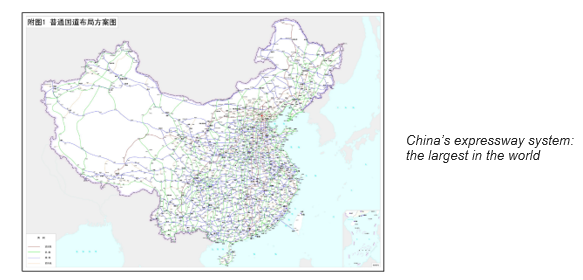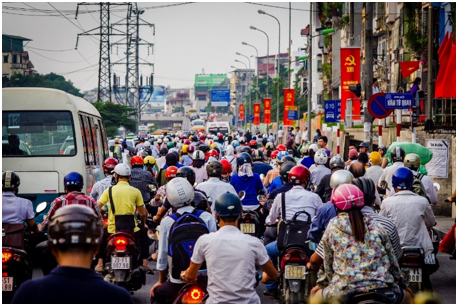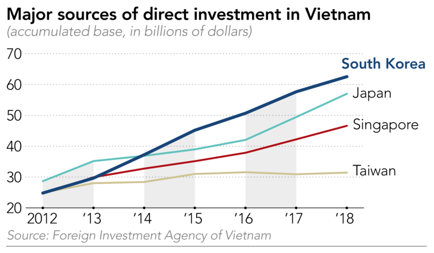As of today (Sep.2019), the US-China trade war is still ongoing very fiercely between the 2 super powers. Sourcing from South East Asia is not a new trend but the current situation is boosting the process to a new level for the whole region. Among this region, Vietnam appears as one of the big Winner of this turmoil. Last week Google announced it was probably moving production of its Pixel smartphone to Vietnam, Apple and Foxconn are considering doing the same, Samsung or LG already have factories in the country and Nike source over 50% of its products from there.
V-Trust has now been operating in China for +15 years and Vietnam for +5 years. As a company operating in both countries with offices in both countries, we know what are the differences and possible challenges when starting operation in Vietnam. We already came across them and are happy to share some insights and experience!
This article takes around 12 minutes to read (=~2800 signs). For a quick overview, please find below a table summarizing our article.

1. Moving from China to Vietnam: is it really that cost-effective?
Yes, labor cost is lower in Vietnam.
Yes labor cost keeps rising in China, to a level that China is not that much competitive for intensive labor manufacturing compared to many other countries. The storm caused by the US/China trade-war is only of the reason to explore new sourcing destinations, but the picture is much bigger than that. China is not the cheap factory of the world it used to be and that’s maybe actually for the best of China. Labors are more and more skilled, a rising middle class has emerged with +400 million people, and its domestic market is slowly replacing an export oriented economy.
On the long term, rising labor cost will be one of the main reason motivating buyers to source elsewhere, and why not in Vietnam?
Vietnam is today a perfect destination for labor intensive manufacturing and a more cost effective solution than China, thanks to lower salaries, a more moderate growth of wages and one of the youngest labor forces in the world.
From the interviews with workers during the SMETA social audits we perform, a low skilled worker on a production line in a Vietnamese factory typically makes around $300 a month (overtime included) while his Chinese counterpart makes around $600 a month (overtime included) in coastal China. On top of that, many Chinese factories would also provide a dormitory for their workers, something that we have very rarely noticed in Vietnam.

Is Labor cost the only thing to take into account to estimate the total cost?
So yes, salaries are undoubtedly lower in Vietnam in the manufacturing industries and you could save on that. However, looking only at labor costs would be a mistake, some other costs should also be taken into account:
- Machineries are very often imported from abroad (often from China). It means higher cost but also possible long delays if any replacement or spare parts are needed.
Injection mold maker for instance are not available in Vietnam, only a few factories have the know-how and equipment to make their own mold. - Raw material are often also imported (again, often from China).
Take fabric for instance, it’s only the beginning of a real fabric industry “made in Vietnam” (often Korean managed). Most of the fabric used in Vietnam are still imported.
Importing raw material often increase the price per unit but also bring extra risk to your supply chain.
- Vietnamese Infrastructures are definitely not up to the Chinese standards. A much higher transportation cost can also even lead to a higher price per unit than when producing in China, and we are not even taking into account possible delays arising from poor infrastructures. We will come back to this in point 4 of our article.
- Many factories are foreign owned in Vietnam (barely the case in China). This certainly has advantages (easier communication and usually a better quality) but it also means higher cost to have 10 to 50 foreign managers based in the factory (Korean, Taiwanese, Chinese, Japanese, sometimes even European or Americans). We will come back to this in the point 5 of our article.
As we have just seen, solely looking at labor costs is not enough.
2. Higher tariff threat for China on one hand, numerous Free Trade agreement for Vietnam on the other hand
Yes, we need to start by mentioning the US-China trade war. It all started in July 2018, and it’s only escalating since then with the world’s two largest economies imposing tariffs on billions of dollars’ worth of one another's goods (over $360 billion of Chinese goods imposed by tariff by the US and over $110 billion of US goods imposed by tariff by China, as of September 2019).
But this is only the tip of the iceberg, this is probably only the beginning of a bigger story, even if the two superpowers come to an agreement. The Western world (and not only the US) in general is afraid of losing its supremacy, afraid of the Chinese rising superpower.
The US started a trade war with China, Europe reached a record high trade deficit with China of $205 Billion in 2018, China is today seen as a potential future worldwide leader in key industries such as the telecommunications (and the 5G), artificial intelligence, self-driving cars. China influence is not only economical, its military spending rose by 83% in real terms between 2009 and 2018, by far the largest growth spurt in any major country, enabling China to deploy precision missiles and anti-satellite weapons that challenge American supremacy in the western Pacific.
Its influence is now seen in Latin America (roughly $150 billion loaned to Latin American countries since 2005), in Europe (one example among many other with Greece’s Piraeus port now being almost entirely run by China’s Cosco Holding). The whole trade war is probably only the beginning.

On the one hand, we have China facing more and more challenges to export its products (not only by the US but probably by the Western world in general in the near future). On the other hand, Vietnam has been extremely active in signing bilateral trade agreements with countries throughout the world.
|
Vietnam Free Trade agreements |
|
|
Already applied |
Upcoming or under negotiation |
|
ASEAN - (AFTA) |
Regional Comprehensive Economic Partnership (RCEP) |
|
Comprehensive and Progressive Agreement for Trans-Pacific Partnership (CPTPP) |
Vietnam-Pakistan FTA |
|
Vietnam-Ukraine FTA |
|
|
US-Vietnam Bilateral Trade Agreement (BTA) |
Vietnam Russia Eurasian Economic Union FTA |
|
ASEAN FTA with: India (AIFTA) |
|
|
Japan-Vietnam Economic Partnership Agreement (VJEPA) |
|
Since joining the World Trade Organization (WTO) in 2007, Vietnamese authorities have been extremely proactive (and often very successful) at pursuing free trade agreement around the world.
It is a full member of the Association of Southeast Asian Nations (ASEAN). A membership that also gives access to Free Trade Agreement (FTA) with Australia, New Zealand, China, Japan, India and Korea.
Since 2018, Vietnam has also been part of the Comprehensive and Progressive Agreement for Trans-Pacific Partnership or CPTPP (a global market of over 500 million people).
More recently and most importantly, in 2019, Vietnam signed The European Union Vietnam Free Trade Agreement (EVFTA), an ambitious pact providing almost 99 percent of elimination of custom duties between the EU and Vietnam (71 percent of duties will be eliminated on Vietnam exports to the EU right now, with the remaining will be eliminated over a period of seven years).
US-Vietnam Bilateral Trade Agreement (BTA) have been in effect since 2001. Trade has been growing by almost 20 percent since then, and the withdrawal of the US from the CPTPP had no substantial effect on the trade between the two countries so far.
3. China manufacturing powerhouse VS Vietnam still limited manufacturing scene
China is just so convenient when it comes to manufacturing. Almost everything can be made and found in China. Not any country in the world can compete when it comes to the diversity of suppliers. This makes it easy to adapt your products in no time, change its design, find a new accessory, and replace a feature. Something usually lacking in Vietnam. Our client in China usually ask themselves “Where can I find the best price for the quality level I am expecting”, in Vietnam it will rather be “Can it even be made in Vietnam in the first place”? At the moment, Vietnam simply can’t offer the level of diversity that China currently offer.
And even if you find the factory that can produce your good, you can meet the following situations:
- MOQ in Vietnam are usually high (usually much higher than in China), especially with the biggest factories. These factories are only working with worldwide brands such as H&M or Zara. Sometimes they won’t even bother answering to your inquiry if they judge you are too small (it happened more than once to some of V-Trust clients’).
- The mindset of factories owner in Vietnam is also different from China. We met numerous Vietnamese owner who told us they were not looking for new customers at the moment and not taking inquiries. For different reasons, sometimes because the conjuncture is really too good at the moment with the US-China trade war, demand is higher than the supply, sometimes because they don’t have any capacity, and don’t plan to get bigger to avoid headaches and changing managements habits for a bigger factory.
- Machineries, raw material and accessories are often imported from abroad (often from China) and can lead to delay. More importantly this situation slow down the willingness of factories to change product manufacturing process, to adjust machineries and order accessories from new suppliers. Changing your product design can become a headache in Vietnam, something that could be solved practically overnight in China with a few emails.
4. A huge Infrastructure developments gap between the 2 countries
China simply has world class transport infrastructures, especially on its coastal area, probably even of better quality than in most Western countries.
It hosts 7 of the world’s 10 busiest shipping ports (Shanghai, Shenzhen, Ningbo-Zhoushan, Hong Kong, Guangzhou, Qingdao and Tianjin), 2/3 of the world total high speed rail with 29,000 kilometers (18,000 miles) of tracks and the world's largest expressway system by length (142,000 kilometers – 88,500 miles), having surpassed the overall length of the American Interstate Highway System since 2011 (77,000 kilometers - 48,000 miles).
This top notch infrastructures makes its super-efficient to visit suppliers, transport your goods to world’s biggest ports, find new suppliers to change some parts of your products or raw material, motivate workers to come and work in coastal areas, etc. China’s infrastructure and logistics network is so good that it can even sometimes make it up for higher labor cost or additional tariff.

On the other hand, Vietnam limited infrastructures development can be a major limiting factor. Expressway are still almost inexistent, 40% of paved roads are not in good conditions and only 19% of its road system are currently paved.
Let’s say you are planning to visit a factory around 50 kilometers Ho-Chi-Minh city or Hanoi, this trip will take you no less than 2 hours in average, due to traffic jam, predominance of motorbikes slowing down the traffic and poor road conditions. Be aware before organizing your next business trip in Vietnam!
Although to be fair, Vietnamese government is now planning for huge investment in transport infrastructures with a high speed train connecting Hanoi and Ho Chi Ming (a trip that currently takes around 35 hours) and an expressway of around 2000 kilometers (1300 miles) from the Chinese border in the north to the southern part of the country. Both projects are planned to be completed by 2030.

A very common Scene in Vietnam where over 45 million motorbikes are registered in contrast to only 2 million cars registered, making it one of the highest motorbike ownership rates worldwide and causing traffics on a daily basis.
5. Foreign owned manufacturing
While foreign owned factories are quite a rare thing in China, Vietnam is welcoming foreign investment in its manufacturing industries and makes it’s even fairly easy to open foreign owned factories.
We conduct hundreds of inspection and audits every year in Vietnam, among the factory we visit it is very common that some of them are actually managed and owned by Korean, Mainland Chinese, Taiwanese, Singaporean, Japanese and even European or American. These factories often have between 10 and 100 foreign staff directly based in the factory to manage the production and Vietnamese workers. They usually have a broad experience in their respective industry, offer a better quality level and apply a stricter production process. Dealing with a foreign owned factories maybe less intimidating and risky for your first cooperation with Vietnam.

In 2019, with the numerous Chinese owners opening factories in Vietnam, Chinese Direct Investment will probably be the largest one.
A new trend with Chinese factories opening branches in Vietnam is also appearing. Although Chinese manufacturers have been there for a while, the scale is now incomparable and largely boosted by the trade war. The first quarter of 2019 saw foreign investment in Vietnam rise by 86.2 per cent, to US$10.8 billion, with Chinese investment accounting for almost half of that. A Vietnamese real estate company recently informed us that because of Chinese manufacturers they sold more factories lease in the first 8 months of 2019 than in the last 8 years of business, this is how big the trend is. Chinese manufacturers often see Vietnam as the number one choice where to relocate to offset the trade war impact. As such, who knows? Maybe your Chinese supplier is already opening a factory in Vietnam? Why not asking him directly?
This could be an absolute win-win situation, the relationship you built over the years would not be wasted, you would still be working with the same supplier, they are already familiar with your requirements and will even probably relocate some of its Chinese staff to manage Vietnamese workers.
Thank you for reading our article! Do not hesitate to share.
If you’re in need of any support in supplier evaluation or quality control services in Vietnam or other Asian countries, please feel free to contact us at vietnam@v-trust.com. We are always more than willing to answer questions, share insights or provide contacts to help you achieve your goals in Asia.
Related Articles:
Top 3 sourcing channels in Vietnam
Sourcing from Vietnam: Pros and Cons
Vietnam and European Union Free Trade Agreement
Differences in Business Mentality between China and Vietnam
5 Practical Tips on How to Source Furniture from Vietnam
A SWOT Analysis of Wood Furniture in Vietnam
Vietnamese New Year and Chinese New Year: difference and similarities
Industry Geography of Vietnamese - developing supplier network
V-Trust Inspection Service is an independent third-party inspection company founded in 2003 with a sound inspection network covering China, Vietnam, Cambodia, Malaysia, India and Bangladesh. Our 300+ full-time inspectors are well trained, reliable and experienced in inspection for a wide product range. In 2018, more than 3,200 importers and buyers all over the world benefited from V-Trust inspection services, and we conducted over 6,200 inspections per month.
As in any other countries where V-Trust operate, all our V-Trust Vietnam inspectors are our full time inspectors only, hired by us, trained by us and working for us only. V-Trust also has its own management team directly and full time based in Vietnam, in HCM.




의견